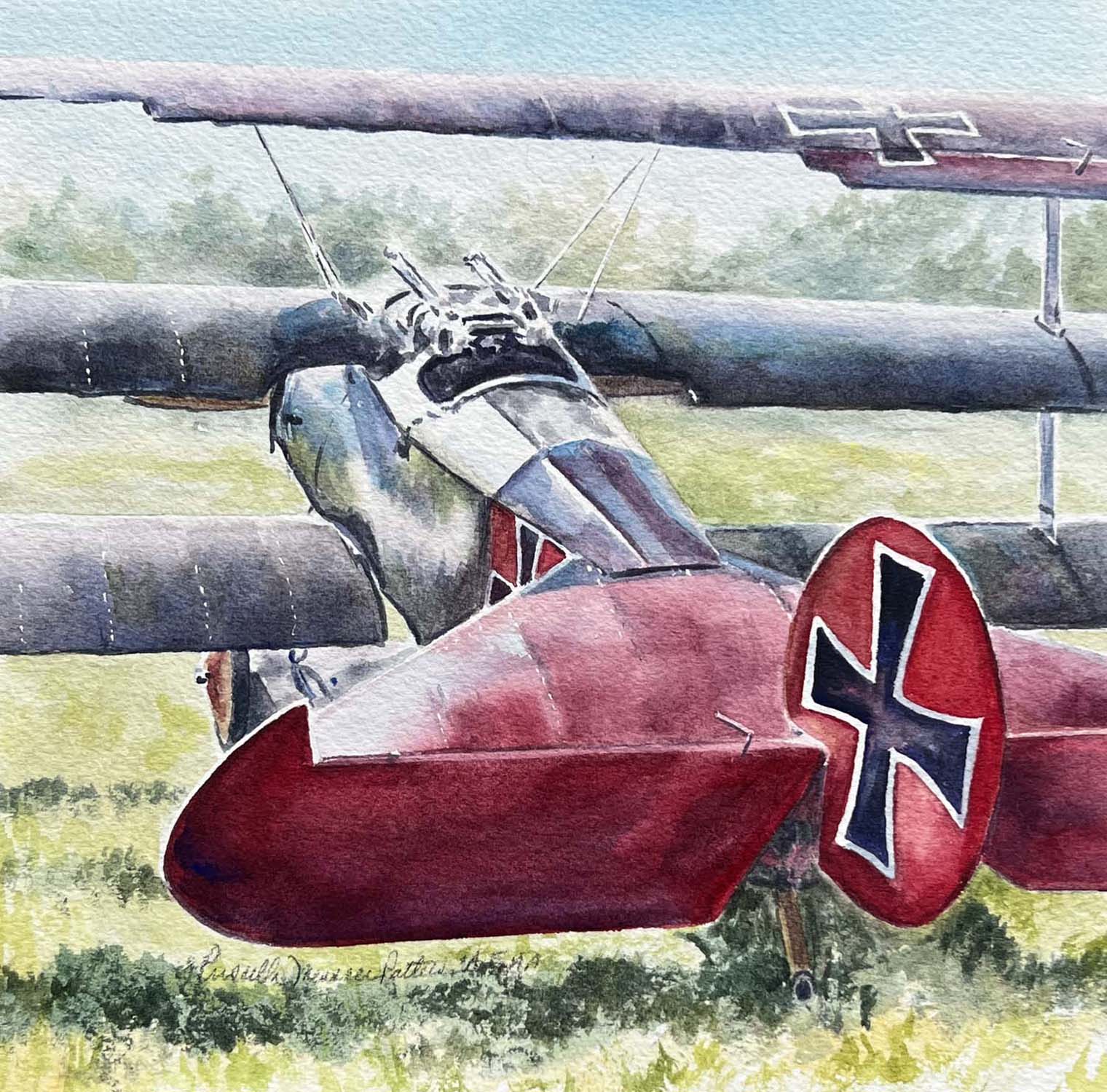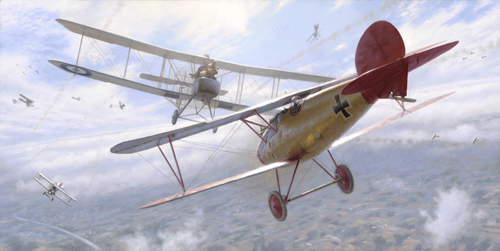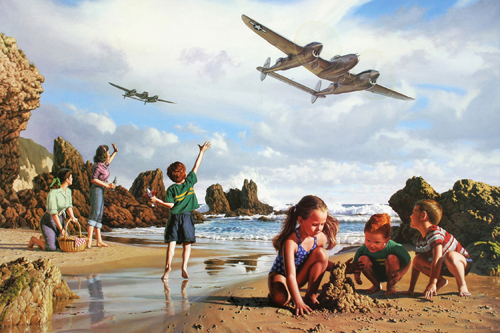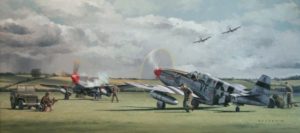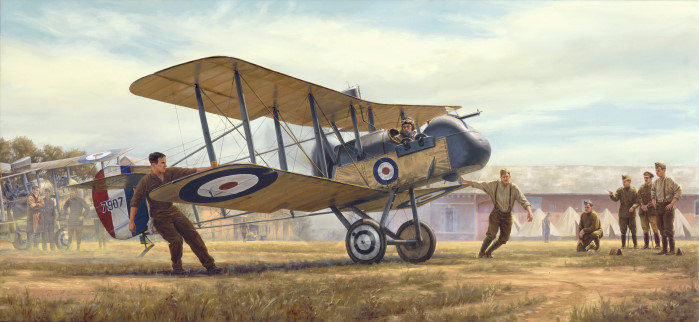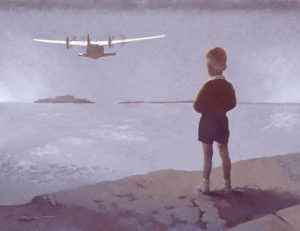2017 Hampton
Paul Rendel
“Wright Stuff”
30” x 24” Oil
The Wright Brothers started with a dream; man can fly like a bird. After many years of study they were able to understand the engineering needed for man to fly. ILC DOVER, a world leader in the innovative design and manufacturer of space suits for NASA, was awarded as the prime contractor for the Apollo Lunar Space Suit in the 1960’s. What would the Wright Brothers think of man traveling to the Moon?

2016 Kalamazoo
Crissie Murphy
“Incoming”
30” x 15” Acrylic
A few years ago, I had the opportunity as a member of the USAF Art Program, to travel to Fort Bragg/Pope Air Force Base, North Carolina, to draw Special Ops Forces Combat controller training. This elite group of men, drawn from all ratings, volunteers to serve in the “First There” (their motto) Combat Control Unit. This is the advance-advance team that drops behind enemy lines and sets up a control operating location from which they coordinate air strikes, determine the ground conditions in establishing landing zones, takeoffs, and troop movements; in other words the crucial link to a successful operation.
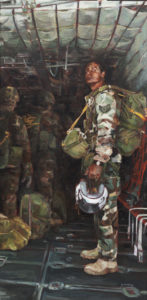
2015 Savannah
John Clark
“Dawn of the Space Age”
16” x 20” Oil
Sputnik-1 was the first artificial Earth satellite. It was a 58cm (23 in) diameter polished metal sphere, with four external radio antennas to broadcast radio signals. The Soviet Union launched it into an elliptical low Earth orbit on 4 October 1957.
2014 San Diego
Steve Cox
“Storm Front”
24” x 36” Acrylic
During WWII, US Navy primary train- ers were not equipped with radios. Since weather predictions were sel- dom far ahead of the actual weather, a few aircraft were given special recall paint schemes, so that students would know to “land now!” when they saw these unmistakable markings. This Boeing built N2S-5 is leading a gaggle of nervous student pilots home, ahead of an approaching storm front.
2013 Baltimore
Russell Smith
“The Eagle and The Butterfly”
22″ x 45″ Oil
“The Eagle and the Butterfly” depicts the wounding of Manfred von Richthofen in his Albatross D.V on July 6, 1917, during an attack on a flight of F.E.2ds from 20 Squadron RFC.
2012 Kalamazoo
Mark Pestana
“The Silent War”
24″ X 36″ Acrylic
At a remote location somewhere on the periphery of the Soviet Union, a MiG-23 intercepts a US Air Force RC-135 “Rivet Joint” reconnaissance aircraft. The interceptor, known by its NATO code name, Flogger, is armed to defend its sovereign airspace as the RC-135, equipped with various sensors, conducts an unarmed signals intelligence mission. For much of the Cold War, various models of RC-135s from the 55th Strategic Reconnaissance Wing were deployed worldwide on extended duration missions to gather data vital to the national command authorities. The artist served as an RC-135 pilot during the 1980s.
2011 Pensacola
Charles Thompson
“Somewhere in England”
15.8” X 23.6” Oil
It is a warm summer morning in 1940 and a Supermarine Spitfire Mk VB of No.19 Sqdn. sits in the corner of an RAF airfield ‘Somewhere in England’ with the cockpit door open, the pilot’s parachute harness resting on the wing and the trolley starter motor connected, just waiting to be scrambled into deadly combat. Mist is rising from a nearby stream and a kingfisher successfully catches his breakfast, completely ignoring the No Fishing sign. The peaceful countryside on the one hand completely belies the imminent presence of war on the other.
2010 San Diego
Stan Vosburg
“Twin Tails and Carrot Tops”
30″ X 42″ Oil
Two “Rosy Riveters” from the ball turret factory in Anaheim, California, have traveled to Corona del Mar for a brief respite from their grueling work schedule and to let their children play in the shallows at low tide. Military airplanes flying overhead were a common sight, but it was always exciting to see the P-38s of the Home Defense group up close and low. The finishing touch to a sand castle is a worthy work of art, but for one of the redheaded twins the approach and roar of two supercharged Allison engines is enough to send him leaping in ecstasy.
2009 Savannah
Gil Cohen, ASAA“Almost Home”
28″ x 46″ Oil
Just a year or two earlier, the bomber boys could be found in the classroom, on the job or at the ballpark. Now, aboard B-17’s, they bomb the German War Machine and targets like Schweinfurt, Regensburg, Bremen or Berlin. On today’s mission, frost covers their windshields. They grit their teeth through skies blackened by flak and fighters. Finally, the friendly coastline of Dover appears. Intense relief shows on the crew’s beaming faces. One crewman may be wounded, and engine may be out, but they are Almost Home.
2008
Wade Meyers“Mission form Debden”
(19″ x 42″ Oil)
Having returned from the first Russia Shuttle mission (Operation FRANTIC) less than two weeks earlier, 4th Fighter Group pilot Capt. Neil “Dutch” Van Wyk steals a quick glance at his dog “Colonel” as he prepares to depart from Debden on an escort mission circa mid-July 1944. Van Wyk’s P-51B Mustang was appropriately named FLYING DUTCHMAN. “Dutch” flew with the 4th from October 1943 until February 1945. Though not an ace, Van Wyk was regarded as a solid troop and promoted to squadron operations officer, leading many missions.
2007
Russel Smith”Release the Hounds”
18″ x 40″ Oil
The Airco DH2 wasdesigned in 1915 as a single seat scout by British aircraft designerGeoffrey de Havilland. Powered by a 100hp Gnome rotary engine, the DH2’s pusher design was de Havilland’s answer to the problem of firing through the propeller -place the pilot and gun in front of the engine. Although inadequate when compared to later scout designs, the DH2 was a successful fighter for its day and played a major role in bringing an end to the reign ofthe German Fokker Eindekkers. The machine seen here was assigned to 32 Sq based at Vert Galand, one of the best known British aerodromes on the Western front. This field saw continuous use from 1915 until 1919, and many of the WWI era buildings can still be seen there today.
2006 Lancaster/Palmdale/Edwards AFB
Ron Hart“Treasure Island”
30″ x 26″ Pastel on Sanded Paper
A Pan American Airways Clipper, a Boeing 314, begins another journey across the Pacific. A young boy watches from across the bay somewhere near Treasure Island, California. Circa: 1943.
